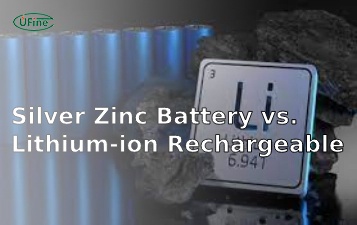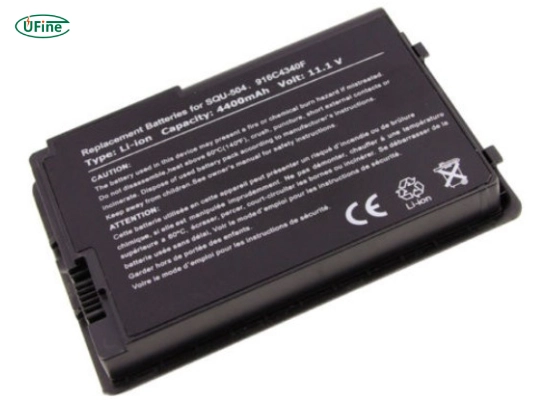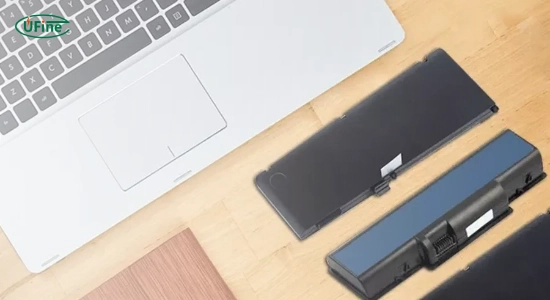
Laptop batteries are indispensable, empowering portable computing and enabling users to work, study, or entertain themselves without being tethered to a power outlet. This article explores various types of laptop batteries and essential maintenance techniques.
Part 1. Types of laptop batteries
Lithium-ion Batteries (Li-ion)
- Most Common: Li-ion batteries are prevalent in modern laptops due to their high energy density and lighter weight than other battery types.
- No Memory Effect: They don’t suffer from the memory effect, allowing users to charge them partially without reducing their overall capacity.
- Longer Lifespan: Li-ion batteries generally have a longer lifespan than other battery chemistries if adequately maintained.
Lithium Polymer Batteries (Li-Po)
- Enhanced Flexibility: Li-Po batteries are more flexible in shape and size, allowing manufacturers to create thinner and more compact laptop designs.
- Lightweight: Similar to Li-ion batteries, they offer lightweight solutions for ultra-portable laptops and devices.
- Lower Profile: Their flat and flexible nature makes them suitable for unconventional laptop designs and configurations.
Nickel-cadmium Batteries (NiCd)
- Older Technology: NiCd batteries were commonly used in earlier laptop models but have been largely replaced due to their lower energy density and toxic cadmium content.
- Memory Effect: These batteries are susceptible to the memory effect, reducing their capacity if not fully discharged before recharging.
- Environmental Concerns: The presence of cadmium makes NiCd batteries environmentally unfriendly, contributing to their declining usage.
Nickel-Metal Hydride Batteries (NiMH)
- Moderate Energy Density: NiMH batteries offer an average energy density, falling between NiCd and Li-ion batteries.
- Reduced Memory Effect: While less prone to memory effect than NiCd batteries, NiMH batteries still benefit from occasional total discharges for optimal performance.
- Eco-Friendlier Option: NiMH batteries are more environmentally friendly than NiCd batteries due to the absence of toxic cadmium.
Solid-State Batteries (SSBs)
- Emerging Technology: SSBs are a promising advancement in battery technology, using solid electrolytes instead of liquid or gel electrolytes in traditional batteries.
- Improved Safety and Stability: They offer enhanced safety, higher energy densities, and potentially longer lifespans than conventional batteries.
- Potential for Future Integration: Although still in the developmental stage, SSBs could revolutionize laptop batteries by providing higher capacities in smaller, safer form factors.
Part 2. Importance of a reliable laptop battery
Enhanced Productivity
A reliable laptop battery is crucial for uninterrupted work. It ensures that professionals, students, and anyone reliant on their laptops can continue their tasks without disruptions caused by sudden power failures or the constant need to be tethered to a power outlet.
Portability and Mobility
The essence of a laptop lies in its portability. A reliable battery extends this advantage, enabling users to work or perform tasks while moving. This aspect is particularly significant for travelers, remote workers, and individuals who work in various locations without immediate access to power sources.
Work Efficiency and Flexibility
A consistent and long-lasting battery allows individuals to structure their work schedules without constraints. They can choose where and when to work without being limited by the availability of power sockets, fostering a more flexible and efficient workflow.
Avoidance of Data Loss
Abrupt power loss can lead to data loss or corruption, especially if work or projects are not saved correctly. A dependable battery mitigates this risk by providing ample time to save documents and safely shut down systems.
Part 3. How to choose the right laptop battery?
Choosing the right laptop battery is crucial for maintaining your device’s performance and longevity. Here’s a detailed guide to help you make the best choice:
1. Know Your Laptop Model and Specifications
First, identify your laptop’s model and specifications. This information is usually found on a label on the bottom of the laptop or in the user manual. Knowing the exact model helps you find a compatible battery. Manufacturers often have specific batteries for different models, so this step is essential.
2. Check the Battery Type
Laptops typically use Lithium-ion (Li-ion) or Lithium-Polymer (Li-Po) batteries.
- Li-ion Batteries: These are common due to their high energy density and longer lifespan. They are lightweight and have a low self-discharge rate.
- Li-Po Batteries: These are similar to Li-ion but are more flexible in shape, making them suitable for ultra-thin laptops. They are slightly more expensive but offer similar performance.
Choose the type that matches your laptop’s original battery.
3. Consider Battery Capacity (mAh and Wh)
Battery capacity is measured in milliampere-hours (mAh) or watt-hours (Wh). A higher capacity means longer battery life.
- Milliampere-Hours (mAh): Indicates how much charge the battery can hold. Higher mAh means more power and longer use between charges.
- Watt-Hours (Wh): Represents the total energy stored. It’s calculated as Voltage (V) x Capacity (Ah).
For example, a battery with 4000mAh and 10.8V will last longer than one with 3000mAh and 10.8V.
4. Look for Genuine OEM Batteries
Always opt for Original Equipment Manufacturer (OEM) batteries when possible. These are made by the same company that made your laptop, ensuring compatibility and safety. Aftermarket batteries might be cheaper but can be unreliable and even dangerous.
5. Evaluate Battery Life Expectancy
Check the expected number of charge cycles a battery can handle before its capacity diminishes significantly. Most laptop batteries last between 300 to 500 charge cycles. Some high-quality batteries can last up to 1000 cycles.
6. Verify the Warranty
A good warranty period (usually 1 year) is essential. It indicates the manufacturer’s confidence in their product. Avoid batteries without a warranty, as they may not be reliable.
7. Ensure Safety Features
Modern batteries come with various safety features like overcharge protection, short circuit protection, and temperature control. These features are crucial for preventing damage to the battery and the laptop.
8. Compare Prices
While price shouldn’t be the only deciding factor, comparing prices from different sellers can help you get the best deal. Remember, extremely cheap batteries might compromise quality.
Part 4. Laptop battery care tips
Avoid Extreme Temperatures
- Avoid Heat Exposure: High temperatures can degrade battery health. Keep laptops away from direct sunlight and avoid leaving them in hot environments like a closed car during summer.
- Cold Temperatures: Extremely low temperatures can also affect battery performance. Avoid exposing laptops to freezing temperatures for extended periods.
Optimal Charging Practices
- Avoid Overcharging: Continuously leaving a laptop plugged in after fully charged can stress the battery. Unplugging it when fully charged helps preserve its longevity.
- Partial Charging is Okay: Unlike older battery types, modern lithium-ion batteries don’t suffer from the memory effect, so partial charges don’t harm them.
Calibrate the Battery
- Regular Full Discharges: Occasionally, allowing the battery to fully discharge before recharging can recalibrate the battery’s power gauge, providing more accurate readings of the remaining charge.
Mindful Usage Patterns
- Power-Hungry Tasks: Intensive tasks like gaming or video editing drain the battery faster. Use them sparingly if you need to be plugged into a power source.
- Reduce Background Processes: Limit unnecessary applications or background processes that consume battery power unnecessarily.
Proper Storage Techniques
- Charge Level for Storage: If storing a laptop for an extended period, maintain the battery charge at around 50%. Avoid storing it fully charged or fully depleted.
- Store in a Cool, Dry Place: Store laptops in a relaxed, dry environment with moderate temperatures to preserve battery health.
Regular Care
- Keep the Laptop Clean: Dust and debris can impact a laptop’s cooling system, causing it to overheat and affecting battery performance—regularly clean vents and fans.
- Software Updates: Keep the Laptop’s operating system and firmware updated to ensure optimal power management settings.
Invest in Quality Accessories
- Use Genuine Chargers: Using compatible, genuine chargers and accessories recommended by the laptop manufacturer ensures the proper power flow to the battery.
Part 5. FAQs
-
How long does a laptop battery last?
The lifespan of a laptop battery varies based on usage, charging habits, and the specific laptop model. Generally, laptop batteries last around 2 to 4 years before experiencing significant degradation in capacity. -
How do I know if my laptop battery is bad?
Signs of a bad laptop battery include reduced battery life, sudden shutdowns even at higher charge levels, slower charging, or a battery that doesn’t hold a charge for long periods. -
What kills laptop battery life?
Several factors can diminish laptop battery life, including frequent total discharges, exposure to high temperatures, overcharging, and leaving the Laptop plugged in for extended periods. -
How do I restore my dead laptop battery?
Fully restoring a dead laptop battery is challenging and might not always be possible. However, some methods, like recalibrating the battery or performing a deep discharge and recharge cycle, could slightly revive its performance. -
What are laptop batteries made of ?
Laptop batteries typically contain lithium-ion (Li-ion) or lithium polymer (LiPo) cells. These cells have electrodes of materials like lithium cobalt oxide, lithium iron phosphate, graphite, and various electrolytes enclosed in a casing with control circuitry.
Related Tags:
More Articles

What is the Difference Between Silver Zinc Battery vs. Lithium-ion Rechargeable?
Compare silver zinc and lithium-ion rechargeable batteries: energy density, cycle life, safety, cost, and uses in drones, medical devices, EVs, and electronics.
What are Watts and Watt Hours in Battery?
Understand watt vs watt-hour in batteries: key differences, how to calculate capacity, and why they matter. Includes free comparison table.
Best 10 Blood Pressure Monitor Battery Review: Finding the Most Reliable
Are you looking for a reliable Blood Pressure Monitor battery? Here is a complete guide with the top 10 best blood pressure monitor batteries.
Bluetooth Headphone Battery Guide: All You Need to Know
Maximize headphone battery life with expert tips! Learn how to charge, check, troubleshoot, and choose the best bluetooth headphone battery in 2025.
LiFePO4 Battery VS. Lithium-ion Polymer Battery: Which One Is Best?
Comprehensive comparison of LiFePO4 vs Lithium Ion Polymer batteries: energy density, safety, lifespan, cost. Find out which battery suits your needs in 2025.




